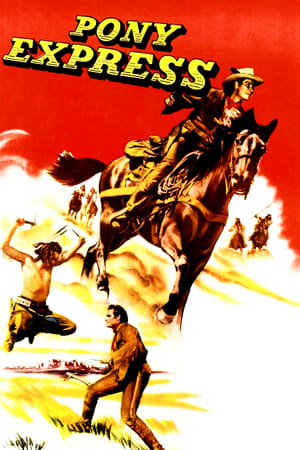
Pony Express
_**Charlton Heston Western about the establishing of the Pony Express**_ As the Civil War looms in 1860, Buffalo Bill Cody (Charlton Heston) and Wild Bill Hickok (Forrest Tucker) team-up to help establish the Pony Express from St. Joseph, Missouri, to Sacramento, California, enabling mail to get from East to West in 10 days rather than 3 weeks by stagecoach. But they have to deal with Separatists who seek to stop the speedy new service (e.g. Rhonda Fleming & Michael Moore), as well as hostile Indians led by chief Yellow Hand (Pat Hogan). “Pony Express” (1953) is an entertaining enough Western with gorgeous Technicolor and a quality cast. How can you go wrong with the formidable Charlton Heston and stunning Rhonda Fleming? Winsome Jan Sterling is also on hand as a Calamity Jane-like woman with eyes for Buffalo Bill. The Pony Express only ran for a year and a half between April, 1860, and November, 1861, wherein it was the most direct means of east-west communication before the transcontinental telegraph was completed by Western Union in late October, 1861, making the Pony Express obsolete. Despite being a financial flop, the Pony Express delivered 35,000 pieces of mail and was vital for linking the new state of California with the rest of the USA. As usual with Hollywood (especially back then), history is mixed with fantasy or legend. While Buffalo Bill Cody almost certainly worked as a messenger boy at Leavenworth, Kansas, for the owners of the Pony Express (which is different from being a rider), he was only 14 at the time, not 29, which Heston was during shooting. Cody of course claimed to have served as a rider in his autobiography, but historians haven’t been able to find proof of this (keep in mind that Cody’s livelihood later in life depended on a constant larger-than-life public relations campaign). Meanwhile Cody did fight & kill Yellow Hair, but that wasn’t until 1876, sixteen years after the events in the movie. I guess that’s why the writers changed the name to Yellow Hand for the movie. As for Hickok, he worked for the Pony Express at the age of 23 as a stableman at the Rock Creek station in eastern Nebraska. Yet the movie drives home the historical reality that working for the Pony Express was a risky business as some 16 employees were killed at relay stations during the Pyramid Lake War of 1860 in Nevada (aka the Paiute War). Meanwhile 8 riders died during the 19 months the Pony Express was in operation: four were slain by hostile Natives; one was hanged for murder after he killed a man while drunk; one died in an unconnected mishap; and two froze to death. To be respected, the movie throws in an honorable cameo of mountain man Jim Bridger (Porter Hall) who discovered the Bridger Pass in south-central Wyoming in 1850, which was used for the Pony Express. While the story could’ve been more compelling, “Pony Express” is relatively entertaining, lacks goofiness, and spurs viewers to look up the real history. The film runs 1 hour, 41 minutes, and was shot in Kanab, Utah; Arizona; and Paramount Studios, Hollywood. GRADE: B-
